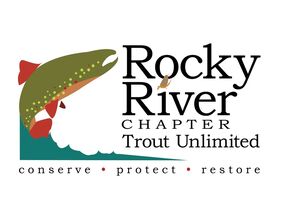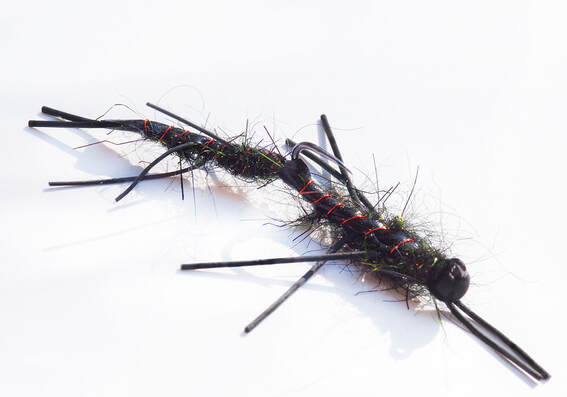Fly of the Month 11.22
The mayfly, the caddisfly, the stonefly and the midge have dozens to hundreds of fly patterns literally for each phase of their life cycle and then some. With all the variations of these four insects mentioned above, one would think that’s all we need to know. But there are many more food choices for trout. What comes to mind are terrestrials that are available for most of the summer. But what is one of the most important available year-round beyond the basic four that we encounter in the southern Appalachians?
Dobsonfly Larva or Hellgrammite
The hellgrammite is the larval stage of the dobsonfly and can be one of the largest insect larva available to both trout and bass while they feed on the bottom. It is also known locally as a “grampus” , “go-devil” or “bottomcrawler” by anglers that use the larva as bait. The dobsonfly in the adult stage is not a viable food source for trout since it spends the entire adult life up to several miles away from water nocturnally finding and mating with another dobsonfly.
The females return to lay their white, circular egg masses on streamside rock ledges or overhanging branches. The larvae hatch from eggs that have been deposited on streamside rocks and crawl or drop into the stream where they live for years underwater and grow up to 2 inches to 3 inches in length.
They live under and around large rocks with the less fortunate hellgrammites serving as a high protein, superior food source for trout. Trout love hellgrammites! The hellgrammite prey on other insect larvae with the short sharp pincers on their head which also can inflict painful bites on humans and draw blood. They have only six legs – the rest of the “legs” are actually gills.
Hellgrammites leave the water by crawling out and burrowing into the muddy streambank. The larvae then find refuge and stay in under large rocks or logs on land in the pupal stage for several weeks before molting and emerging to find a mate. Note, the pupa form is not a viable food source for trout either.
The dobsonfly is nocturnal much like the eastern salmon (stone) fly and the golden stone fly adults. We would probably be imitating the adult life cycle stage of both the dobsonfly and these stonefly species if we did much night fly fishing. (Night fishing for trout is illegal in North Carolina except for the lower Nantahala River where an exception allows anglers to fish without a raft coming down on top of them.). But here in the east, we rely heavily on stonefly nymph patterns and the same is true to imitate the dobsonfly larvae, the hellgrammite.
An angler may experience fly fishing a hellgrammite larva and not even be aware of the occurrence. So how is this possible? At some point we all have fly fished with a black, brown or dark olive woolly bugger. My point is that in general a dark woolly bugger is large, bulky and is an impressionistic imitation of a hellgrammite. Particularity when fished like a nymph (larva) rather than a streamer.
The hellgrammite is such an important food source for trout that we present to you the Devil’s Doorstop, one of many hellgrammite fly patterns. The Devil’s Doorstop originated as a smallmouth fly pattern but it works equally well for trout. An advantage of this fly pattern is the hook up style, allowing the fly to drag on the bottom yet not easily caught by rocks and debris.
Fly of the Month 11.22
Devil’s Doorstop (Hellgrammite)
Tom Adams and Alen Baker
The mayfly, the caddisfly, the stonefly and the midge have dozens to hundreds of fly patterns literally for each phase of their life cycle and then some. With all the variations of these four insects mentioned above, one would think that’s all we need to know. But there are many more food choices for trout. What comes to mind are terrestrials that are available for most of the summer. But what is one of the most important available year-round beyond the basic four that we encounter in the southern Appalachians?
Dobsonfly Larva or Hellgrammite
The hellgrammite is the larval stage of the dobsonfly and can be one of the largest insect larva available to both trout and bass while they feed on the bottom. It is also known locally as a “grampus” , “go-devil” or “bottomcrawler” by anglers that use the larva as bait. The dobsonfly in the adult stage is not a viable food source for trout since it spends the entire adult life up to several miles away from water nocturnally finding and mating with another dobsonfly.
The females return to lay their white, circular egg masses on streamside rock ledges or overhanging branches. The larvae hatch from eggs that have been deposited on streamside rocks and crawl or drop into the stream where they live for years underwater and grow up to 2 inches to 3 inches in length.
They live under and around large rocks with the less fortunate hellgrammites serving as a high protein, superior food source for trout. Trout love hellgrammites! The hellgrammite prey on other insect larvae with the short sharp pincers on their head which also can inflict painful bites on humans and draw blood. They have only six legs – the rest of the “legs” are actually gills.
Hellgrammites leave the water by crawling out and burrowing into the muddy streambank. The larvae then find refuge and stay in under large rocks or logs on land in the pupal stage for several weeks before molting and emerging to find a mate. Note, the pupa form is not a viable food source for trout either.
The dobsonfly is nocturnal much like the eastern salmon (stone) fly and the golden stone fly adults. We would probably be imitating the adult life cycle stage of both the dobsonfly and these stonefly species if we did much night fly fishing. (Night fishing for trout is illegal in North Carolina except for the lower Nantahala River where an exception allows anglers to fish without a raft coming down on top of them.). But here in the east, we rely heavily on stonefly nymph patterns and the same is true to imitate the dobsonfly larvae, the hellgrammite.
An angler may experience fly fishing a hellgrammite larva and not even be aware of the occurrence. So how is this possible? At some point we all have fly fished with a black, brown or dark olive woolly bugger. My point is that in general a dark woolly bugger is large, bulky and is an impressionistic imitation of a hellgrammite. Particularity when fished like a nymph (larva) rather than a streamer.
The hellgrammite is such an important food source for trout that we present to you the Devil’s Doorstop, one of many hellgrammite fly patterns. The Devil’s Doorstop originated as a smallmouth fly pattern but it works equally well for trout. An advantage of this fly pattern is the hook up style, allowing the fly to drag on the bottom yet not easily caught by rocks and debris.
Fly of the Month 11.22
Devil’s Doorstop (Hellgrammite)
Tom Adams and Alen Baker

